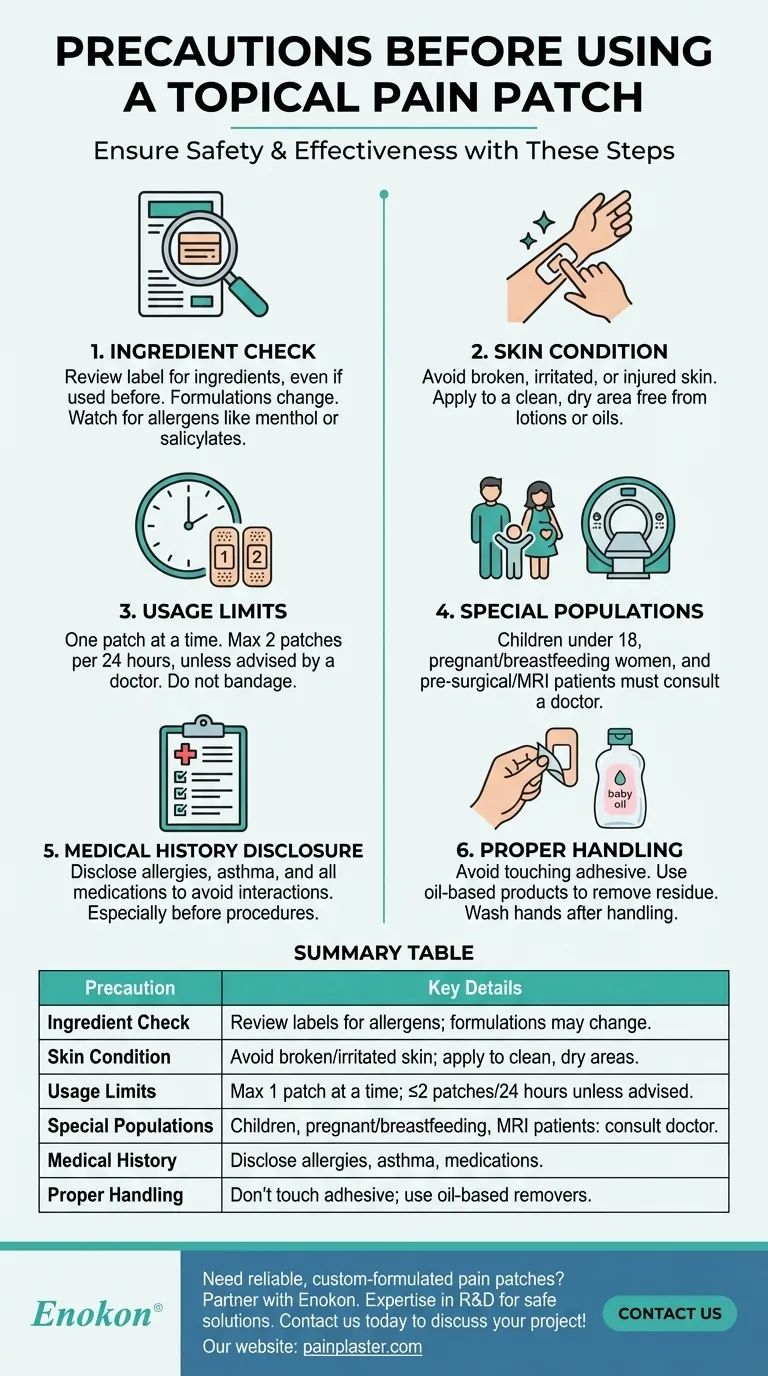Before using a pain patch, several precautions must be taken to ensure safety and effectiveness. Always check the label for ingredients, even if you've used the product before, as formulations may change. Avoid using the patch on broken, irritated, or injured skin, and do not apply more than one patch at a time or exceed two patches within 24 hours. Children under 18 should not use the patch without medical advice. Inform your healthcare provider about any allergies, medical history, or other medications you're taking, especially before surgery or an MRI. Pregnant or breastfeeding women should consult a doctor before use. Proper handling, such as avoiding touching the adhesive side and using oil-based products for removal, is also crucial.

Key Points Explained:
-
Ingredient Check
- Always review the label for active and inactive ingredients, even if you’ve used the product before. Formulations can change, and you may develop new allergies or sensitivities over time.
- Pay special attention to common allergens like menthol, methyl salicylate, or salicylates if you have a history of reactions to these compounds.
-
Skin Condition
- Do not apply the patch to broken, irritated, or injured skin, as this can increase absorption and the risk of adverse effects.
- Ensure the application area is clean, dry, and free from lotions or oils that might interfere with adhesion.
-
Usage Limits
- Apply only one patch at a time, and do not exceed two patches within a 24-hour period unless directed by a healthcare professional. Overuse can lead to systemic absorption and potential toxicity.
- Avoid bandaging the area unless specifically advised by a doctor, as this can enhance drug absorption unpredictably.
-
Special Populations
- Children: Not recommended for those under 18 without medical supervision due to differences in metabolism and potential for higher systemic exposure.
- Pregnant/Breastfeeding Women: Consult a doctor before use, as some ingredients may cross the placenta or enter breast milk.
- Pre-Surgical/MRI Patients: Inform your healthcare team about patch use, as certain ingredients (e.g., metals in adhesives) may interfere with procedures.
-
Medical History Disclosure
- Disclose any history of asthma, nasal polyps, or aspirin sensitivity, as these conditions may increase the risk of adverse reactions to salicylate-containing patches.
- Share all medications (prescription, OTC, supplements) to avoid potential drug interactions.
-
Proper Handling
- Avoid touching the adhesive side to maintain effectiveness and prevent contamination.
- If the patch loosens or falls off, discard it properly and apply a new one. Use oil-based products (e.g., baby oil) to gently remove stubborn residue, then wash hands thoroughly.
By following these precautions, you can minimize risks and maximize the therapeutic benefits of the pain patch. Have you considered how these steps align with your daily health routines? Such small measures often underpin the safe use of technologies that quietly shape modern healthcare.
Summary Table:
| Precaution | Key Details |
|---|---|
| Ingredient Check | Review labels for allergens (e.g., menthol, salicylates); formulations may change. |
| Skin Condition | Avoid broken/irritated skin; apply to clean, dry areas free of oils/lotions. |
| Usage Limits | Max 1 patch at a time; ≤2 patches/24 hours unless medically advised. |
| Special Populations | Children (<18), pregnant/breastfeeding women, or MRI patients: consult a doctor. |
| Medical History | Disclose allergies, asthma, or medications to avoid interactions. |
| Proper Handling | Don’t touch adhesive; use oil-based removers for residue. |
Need reliable, custom-formulated pain patches? Partner with Enokon, a trusted bulk manufacturer of transdermal patches and pain plasters for healthcare brands and distributors. Our expertise in R&D ensures safe, effective solutions tailored to your needs. Contact us today to discuss your project!
Visual Guide

Related Products
- Capsaicin Chili Medicated Pain Relief Patches
- Far Infrared Deep Heat Relief Patches Medicated Pain Relief Patches
- Menthol Gel Pain Relief Patch
- Icy Hot Menthol Medicine Pain Relief Patch
- Lidocaine Hydrogel Pain Relief Patch for Pain Relief
People Also Ask
- Can children use the pain relief patch? A Critical Safety Guide for Parents
- Can pregnant women use pain relief patches? Your Essential Guide to Safe Pain Management
- What is the purpose of capsaicin patches? A Guide to Temporary Pain Relief
- How do pain relief patches work? A Guide to Targeted, Long-Lasting Pain Relief
- Are pain relief patches safe for sensitive skin? Your Guide to Safe Use & Skin Testing
















